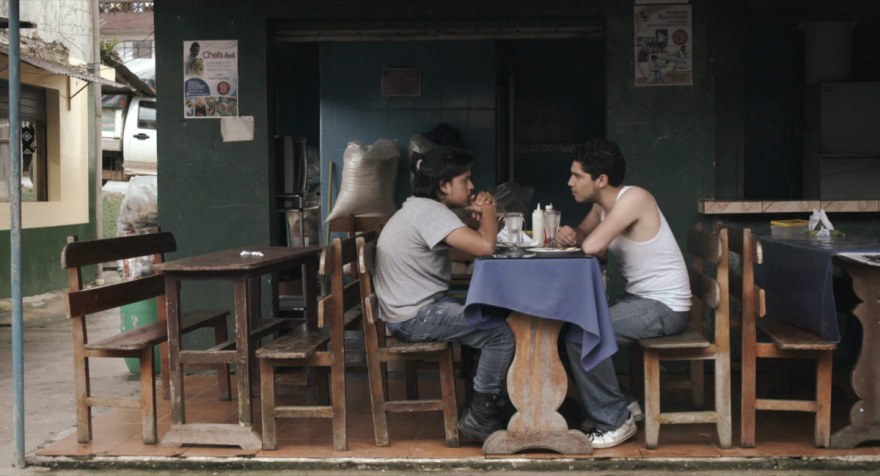Tea time with Burundanga
An interview with Anaïs Ruales Borja, director of Burundanga
Burundanga begins with a sequence in an amusement park and your main character is a ride operator. What attracted you to this particular universe?
I believe it all began from there, from that image that struck me as I walked through a makeshift amusement park in the middle of puddles of water. There was a young man with a firm hold on the speed lever of a boat ride. An immense metal ship full of children swung back and forth. He operated the machine with the confidence of a truck driver, whereas the entire structure seemed on the point of falling apart at any moment. I stood there for a moment watching him work, and then I began to wonder what his life must be like. I’ve always been fascinated by amusement parks, especially those in Ecuador, where everything seems to miraculously work, as magic rises from the rust.
Why did you choose Quito, Ecuador, for the setting of the film?
The main action takes place in a village one hour from Quito, then in Quito itself. In fact, I was born in Quito and spent the first years of my life there. In a way, that city and that country are attached to a vague, almost impressionist memory from my early childhood, the kind of memory we are not sure is real or is the result of an invention from a photo we’ve seen. That is why every time I go back, I discover something of a profound cinematic nature. It is not like in France where we spend our lives surrounded by four walls, sheltered from everything. Over there, everything takes place outside, in the street, where we eat, talk, and also sing. Everything blends together and anything can happen, the beautiful as well as the violent.
However, Burundanga was produced in France. In your opinion, what does French short film production have that the others don’t?
Let us say that I don’t think we can even make a comparison. Over there, from my experience, cinema is just being born, and as a result, making a film is much more of an obstacle course. The price of material is set in relation to the production of advertising, etc. But we can also sense the effervescence of this birth, the youth of this cinematic milieu, and the gradual setting up of structures for artistic financing (completely different from just a few years ago). I know that the French CNC is a major influence on its Ecuadorian equivalent, the CNCiné.
In Burundanga, the main character dreams of a simple life, of romantic success and wealth in the United States. Have you done any research on the motivation which drives certain South Americans to go to the United States?
At the end of the 1990s, one-tenth of the Ecuadorian population left. In contemporary Ecuadorian culture, the question of migration has left a still painful scar. It is something very close to me, but I still needed to read up on it, especially on the idea of the crossing, the journey and the myths that go along with that. For example, the story of la Bestia, the train that makes the crossing toward the United States. Originally, there was a scene or a character that told the story of what happened, of the cartels or the authorities putting a violent end to the journey. And Pablo listens to this story, his desire to leave growing even more with this youthful need of challenge and risk to finally experience life, in contrast with his life up to now, which has been passive and sedentary, spending most of the time lying down or roaming about. That desire to leave, what interested me the most was to express in a palpable way the physical situation of that village which is clearly a prisoner of the mist and of the incessant rain. What is beyond the mountain is elusive for Pablo and for us, making his actual life less consistent and increasing his desire to leave.
Your hero is completely disconnected from reality and any sense of personal responsibility. He sees nothing wrong in the acts he commits. What did you want to denounce more: the influence of drugs, or the sentimental disappointment in his perception of reality?
I think it is everything. Pablo doesn’t give a damn. He has no particular motivation, he has nothing to lose and at the same time he doesn’t dare to take risks. The drugs allow him to live in an unhealthy in-between state where he can finally act without having to confront himself. Like an actor who practices, experiments, driven by others, allowing himself to be driven, whatever may arise.
Finally, in Burundanga, the mother’s failure is made obvious, but we also notice the absence of any kind of father figure. When you made the film, why couldn’t there be a father?
That’s a good question. I haven’t really thought about it. I conceived the family situation like that. The mother also represents that aspect that I love in Ecuador, of the oral tradition, of legends. Having her alone allowed me to avoid having the trivial aspects of the traditional family with its conflicts and discussions take up too much space.
It is her, faced with her son, that is all. As powerless as she may be, they are a small island in themselves. She exists as a mother, but with a certain mystery, ghostliness, also with the stories she tells. We don’t know what is made up, what is real, what is a dream. Everything mixes together and is equal in importance. In Ecuador, that is how it is, stories are used to explain things that are sometimes too painful, like absence or death.
Programme for viewing Burundanga: National Competition F8.








